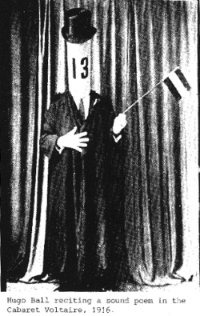 There were also many associated manifestations of Dada
throughout the world, and in particular New York [1]. The Parisian manifestation of Dada eventually
evolved into Surrealism.
There were also many associated manifestations of Dada
throughout the world, and in particular New York [1]. The Parisian manifestation of Dada eventually
evolved into Surrealism. Dada was initially manifested by a group
of German artists who had gone to Zurich to escaped World War I. They later
split up into two groups with one returning to Berlin, while the other went to
Paris.
 There were also many associated manifestations of Dada
throughout the world, and in particular New York [1]. The Parisian manifestation of Dada eventually
evolved into Surrealism.
There were also many associated manifestations of Dada
throughout the world, and in particular New York [1]. The Parisian manifestation of Dada eventually
evolved into Surrealism.
Unlike the Italian Futurists before them who saw constant warfare as a means to create a culture that existed for art, the Dadaists proposed an anti-art that would destroy culture and therefore war. In this regard, at the Cabaret Voltaire, a hangout for pacifists and Bohemians of the day, Hugo Ball (1886-1926) invented a form of anti-poetry in 1916:
I have invented a new genre of poems, Verse ohne Worte, (poems without words) or Lautgedichte (sound poems), in which the balance of the vowels is weighed and distributed solely according to the values of the beginning sequence. I gave a reading of the first one of these poems this evening. I had made myself a special costume for it. My legs were in a cylinder of shiny blue cardboard, which came up to my hips so that I looked like an obelisk... I also wore a high, blue-and-white-striped witch doctor's hat. [2]
Ball is often cited as the 'inventor' of sound poetry [3]. Along with Richard Huelsenbeck (1892-1974), Raoul Hausmann (1861-1971), Tristan Tzara (1896-1963), Marcel Janco (1895-1984) and others, the Dadaist explored the simultaneist poem and the bruitist poem at the Cabaret Voltaire. L'Amiral cherche une maison a louer ('The Admiral is Looking for a House to Rent') for example was a simultaneist group poem performed by Ball, Huelsenbeck, Tzara and Janco. All the performers participated at once with whistling, singing, speaking, and making 'noises'. In part they were influenced by the ideas about noise which Marinetti and Russolo had popularized as well as Orphic chant poetry of Henri M. Barzun [4].
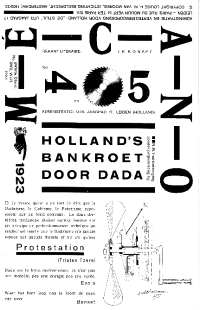 Front page
of Mecano No. 45, Amsterdam (1923).
Front page
of Mecano No. 45, Amsterdam (1923).
With their return to a poetry which they
believed to have existed before words were invented was a strong impulse
towards the 'primitivism' which was common thread with the avant-garde of that
time. Chant negre I and II is an another example from the Cabaret
Voltaire performances, which display's this interest in other cultures and was
a Dadaist conception of an African vocal piece. It was similar in style (and
anthropological inaccuracy) to the earlier Discussione di Due Critici
Sudanesia sul Futurismo by the Italian Futurist, Giacomo Balla. Tzara had
several sound poems, which he called Poemes Negres that he said were
'translations' of poetry from Oceania and Africa. In 'A Note on Negro Poetry,'
he wrote, 'Poetry lives first of all for the functions of dance, religion,
music and work [5].'
Tzara had made his literary debut in 1912 by writing Symbolist poetry. Around 1916 he began to compose poetry which was reminiscent of Guillaume Apollinaire's Cubist college techniques. Tzara would begin a poem by cutting words out of some 'old' poem (by Shakespeare, for example), shaking the words up in a hat, and reading them aloud as he pulling the bits of paper out of the hat and thereby creating a 'new' poem [6].
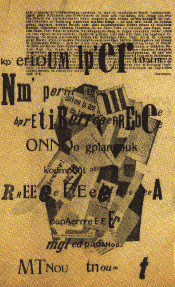 Raoul Hausmann, 'kp'
eriuUM' (1918).
Raoul Hausmann, 'kp'
eriuUM' (1918).
Raoul Hausmann is one of the few Dada
sound poets who had eventually made audio recordings of his sound poetry
[7].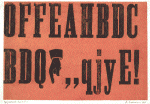 He had developed
a system of notating phonetic poetry in 1918 which he called 'optophonetics'
[8] which used typographical variations in a similar
fashion as the Italian Futurists to cue the manner of performance of the
text.
He had developed
a system of notating phonetic poetry in 1918 which he called 'optophonetics'
[8] which used typographical variations in a similar
fashion as the Italian Futurists to cue the manner of performance of the
text.
A sound poet who was directly influenced by Hausmann, was Kurt Schwitters (1887-1948) the one-man art movement who is usually associated with Dada and Constructivism, though in reality he spent much of his productive career in Hanover doing Merz. Merz was a word which he extracted out of one of his collages, and it represented a totalizing conception of art:
My aim is the total Merz art work, which combines all genres into an artistic unity. First I married off single genres. I pasted words and sentences together into poems in such a way that their rhythmic composition created a kind of drawing. The other way around, I pasted together pictures and drawings containing sentences that demand to be read. I drove nails into pictures in such a way that besides the pictorial effect a plastic relief effect arose. I did this in order to erase the boundaries between genres [9]
Kurt Schwitters, from
PIN (1946/1962)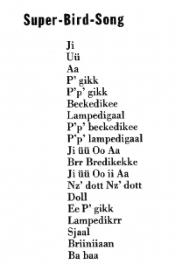
Schwitters was a poet whose 'writing' let him to painting, sculpture, and architecture. Much of his activity was centered around building a Merzbau, a 'cathedral of erotic misery,' which was a sculptural collage in the form of a tower that would absorb his art, his house, the 'banalities' of his environment, and his life. It represented a unifying paradigm for all his activities, and it was conceived of as an object which would restructure reality along artistic principles. He attempted to construct three such towers, but two were destroyed and the remaining one was unfinished.
He tore phrases and everyday objects from their mundane political and social contexts and formed them into a new order which was referential only to themselves. His purely literary pieces explored the edges of sense and nonsense in language, and his experiments with syntax and found phrases which had its roots in German Expressionism [10], resembled the cut-ups of Tzara and much later, Brion Gysin.
In the twenties he was involved in a number of poetry readings of his work along with Raoul Hausmann, Tristan Tzara, Theo Van Doesburg, Hans Richter, and several others doing evenings of Dada poetry and events. It was during one of these tours that he heard Hausmann's sound poem 'bbbbetFmsbw' written in 1918. Between the years 1921 until 1932, Schwitters worked upon a phonetic poem which was based upon the line 'fmsbwtazau' from Hausmann's poem. The result was the sound poetry classic, Die Sonata in Urlauten, a forty minute long phonetic poem ('The letters used are to be pronounced in German') set in a more or less sonata form:
The sonata consists of 4 movements, and introduction, a finale, and (as its seventh part) a cadenza in the fourth movement. The first movement is a rondo with four major themes, which have specific markings in the text of the sonata[11].
The text for the work is written as a score with instructions for a performer to realize the work. Its setting in a traditional music structure has let to some controversy however, that the work is a different kind of poem in design and intent that is not as radical or experimental as Hausmann's originating phonetic poem, and therefore it is not really a 'true' sound poem.